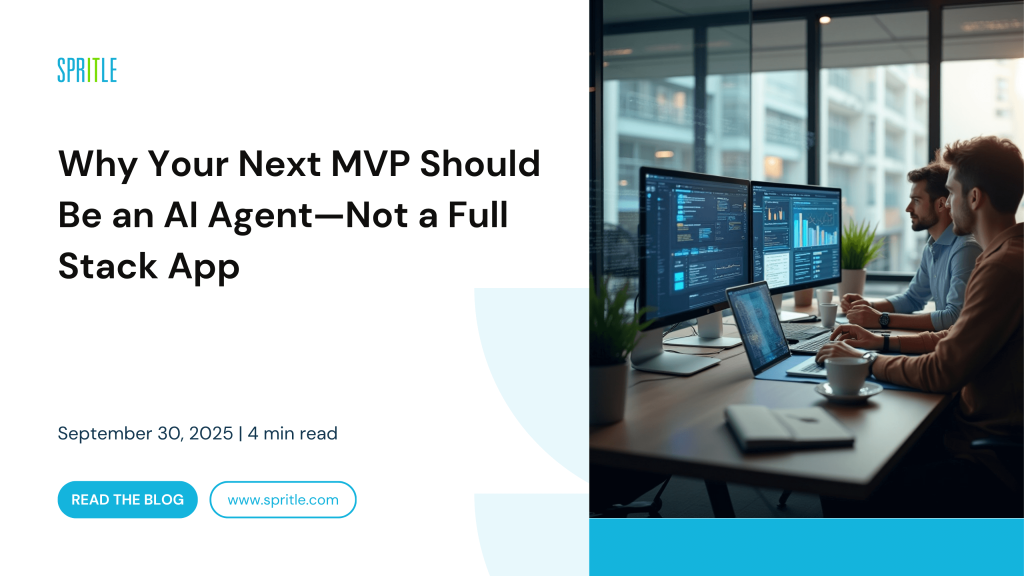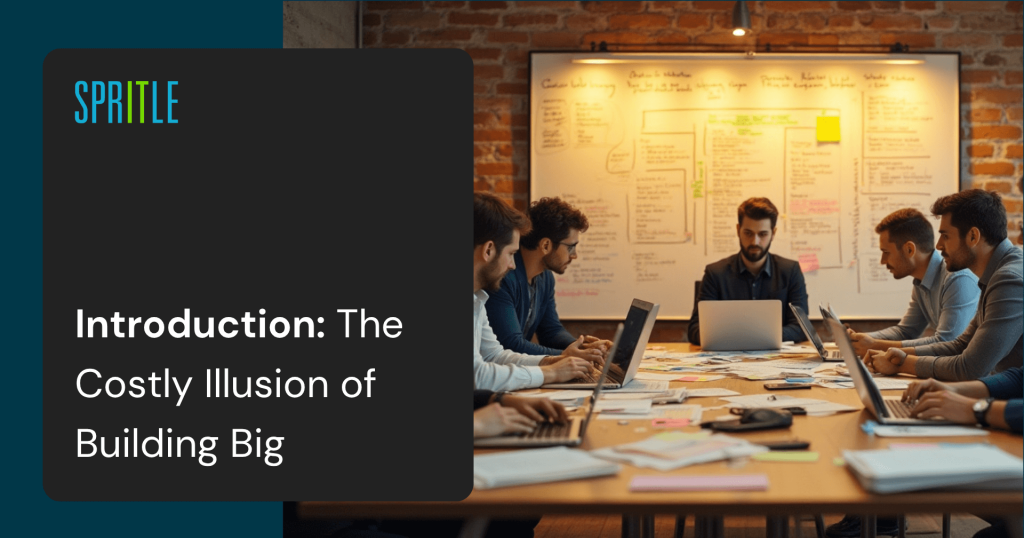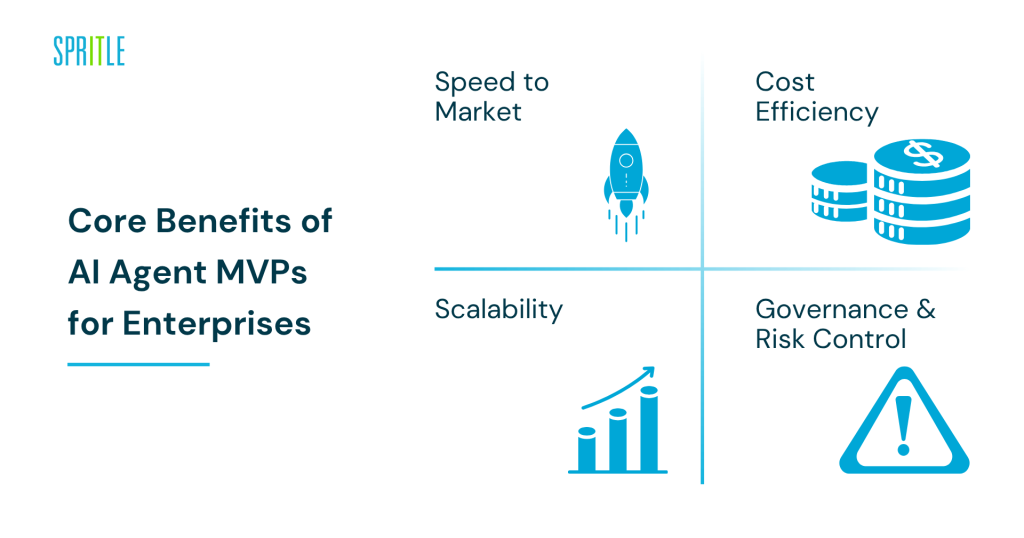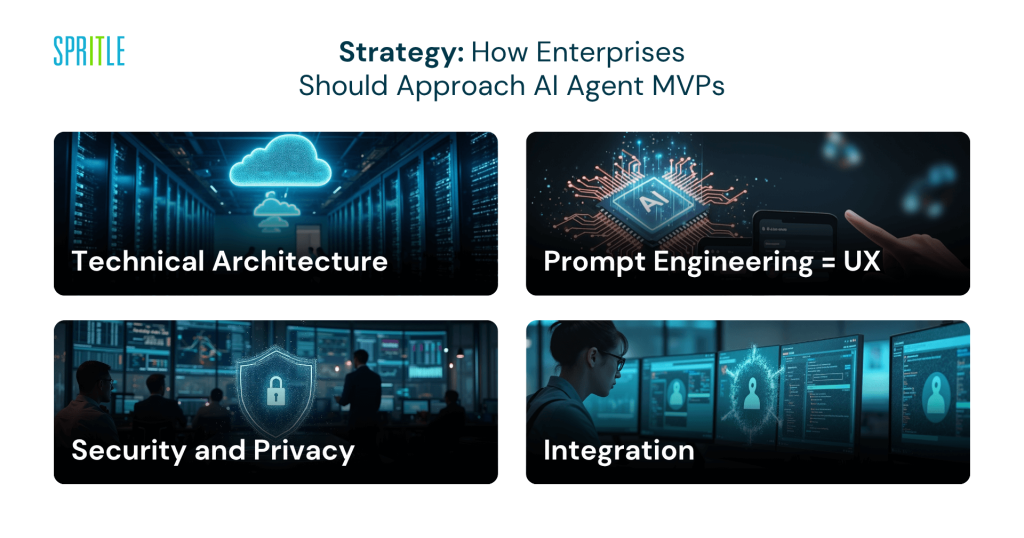
Table of Contents
1.Introduction: The Costly Illusion of Building Big 2.Why Traditional MVP Thinking Breaks in Enterprise Contexts 3.Hitting the Enterprise Wall: When Full-Stack MVPs Fail 4.The Rise of AI Agents: Enterprise-Grade MVPs for Real Impact 5.Full-Stack MVP vs AI Agent MVP — Enterprise Edition 6.Core Benefits of AI Agent MVPs for Enterprises Speed Cost Efficiency Scalability Governance 7.When AI Agents Outperform Full Apps: Enterprise Use Cases 8.Strategy: How Enterprises Should Approach AI Agent MVPs Technical Architecture Prompt Engineering Security and Privacy Integration 9.Lessons from the Field: Real Enterprise Examples 10.Measuring Success: KPIs That Matter 11.Common Pitfalls & How Our Experts Solve Them 12.Future Outlook: What’s Next for AI Agent MVPs 13.FAQs: What Enterprises Are Asking ChatGPT About AI Agent MVPs 14.Final Thought: Smarter, Not Heavier |
Introduction: The Costly Illusion of Building Big
Imagine an enterprise tech team sinking three quarters into building a robust, full-stack MVP — complete with front-end UI, backend APIs, database infra, CI/CD pipelines, auth layers, QA flows. The vision? Grand. The reality? Bloated. Missed deadlines. Scope creep. Slow feedback. Minimal usage.
And here’s the kicker: after all that, users still abandon it after one login.
This isn’t rare. This is the reality of overbuilding, especially in large organizations chasing innovation. But there’s a new, leaner way: launching with AI agents instead of traditional full-stack apps.

Why Traditional MVP Thinking Breaks in Enterprise Contexts
Enterprises are fundamentally different from startups. Stakeholders are more diverse. Approval cycles are longer. The risk of failure is higher — not just financially, but reputationally.
When companies try to build startup-style MVPs inside these environments, they often miscalculate how long it takes to get usable feedback. By the time the MVP launches, priorities have shifted or users have moved on.
In regulated industries like finance or healthcare, the cost of “just testing something” is magnified. This is where AI agent MVPs offer a better path — lean, fast, focused, and less intrusive to existing workflows.
Hitting the Enterprise Wall: When Full-Stack MVPs Fail
Full-stack MVPs often feel necessary in enterprises — stakeholders want polish, IT demands control, leadership expects dashboards. But they come at a cost:
- Slow time-to-market: Approval loops, infra setup, compliance audits
- High capital exposure: Engineering hours, cloud cost, testing overhead
- Delayed feedback: Waiting months for real user behavior data
- Over-commitment: Locking into features before market validation
This isn’t agility. It’s a trap.
The Rise of AI Agents: Enterprise-Grade MVPs for Real Impact
In 2025, AI agents are gaining traction across enterprise sectors because:
- Foundation models have matured (GPT-4o, Claude, Gemini)
- Cost of inference and tuning has dropped
- Open tooling (LangChain, RAG, Weaviate) has become enterprise-ready
What’s an AI Agent MVP?
An AI agent MVP is a domain-tuned assistant that lives inside existing tools (Slack, Salesforce, Notion, Outlook, internal portals), handles repetitive workflows, and delivers immediate user value — all powered by natural language and machine learning.
Key Traits
- No full UI — lives where users already work
- Fast build — weeks, not quarters
- Adaptive — learns from interaction, improves with prompts
- Scalable — can evolve into full apps later
Think of it as launching a co-pilot before building the cockpit.
Full-Stack MVP vs AI Agent MVP — Enterprise Edition
| Feature | Full-Stack MVP | AI Agent MVP |
| Build Time | 3–6 months | 2–4 weeks |
| UI Design Required | Yes | No |
| Infra Setup | Complex | Minimal |
| Compliance Burden | High upfront | Modular, phase-wise |
| Workflow Integration | External | Native (in Slack, Outlook, etc.) |
| Feedback Speed | Slow | Real-time |
| Pivoting Flexibility | Low | High |
Core Benefits of AI Agent MVPs for Enterprises
- Speed to Market
An AI agent can be built, fine-tuned, and embedded in enterprise tools within 2–4 weeks. That’s real feedback, fast.
- Cost Efficiency
No need for expensive design sprints or full-stack dev. You validate business impact at a fraction of the cost.
- Scalability
Start with one team or department. Expand across geographies, verticals, or business units once proven.
- Governance & Risk Control
AI agents can be designed with:
- Role-based access controls
- Data redaction and masking
- SOC2 / HIPAA compliance
- Human-in-the-loop safeguards

When AI Agents Outperform Full Apps: Enterprise Use Cases
Healthcare
- Agent MVP: Voice-based documentation assistant for doctors
- Outcome: Saved 12 hours/week per physician, lowered burnout
Financial Services
- Agent MVP: AI summarizer for compliance updates
- Outcome: Cut research time by 60%, improved policy alignment
Logistics
- Agent MVP: AI routing advisor for delivery ops
- Outcome: Reduced missed SLAs by 35%, optimized fleet usage
HR & L&D
- Agent MVP: Internal AI coach for onboarding
- Outcome: Boosted retention and ramp-up speed
Strategy: How Enterprises Should Approach AI Agent MVPs
1. Technical Architecture
- Start with hosted models (OpenAI, Anthropic, Gemini)
- Use serverless functions to manage cost
- Connect via APIs to internal systems (ERP, CRM, etc.)
2. Prompt Engineering = UX
- Design intuitive system + user prompts
- Use embeddings for contextual memory
- Test across edge cases and user intent variants
3. Security and Privacy
- Encrypt all PII/PHI
- Add usage monitoring and audit logging
- Set prompt restrictions and fallbacks
4. Integration
- Embed in email, chat, dashboards, or extensions
- Avoid asking users to “go” somewhere
- Deliver value in flow, not in friction

Lessons from the Field: Real Enterprise Examples
Case Study 1: AI Agent for Underwriting (Insurance)
Instead of launching a full underwriting app, a global insurer deployed an agent in Microsoft Teams that:
- Summarized claims
- Flagged inconsistencies
- Pre-filled risk profiles
Result: 50% faster processing time, $200K/month saved.
Case Study 2: Legal Contract Copilot
A Fortune 500 legal ops team embedded a GPT-powered Slack bot that:
- Reviewed contracts
- Suggested clause edits
- Escalated exceptions
Result: Reduced review time by 70%, increased legal satisfaction.
Measuring Success: KPIs That Matter
✅ Adoption Metrics
- % of daily active users
- Prompt engagement rate
✅ Efficiency Metrics
- Time saved per task
- Tasks completed per day
✅ Accuracy Metrics
- Reduction in manual errors
- Agent-to-human handoff ratio
✅ Strategic Impact
- Speed to value (weeks to ROI)
- Expansion readiness (multi-region)
✅ Trust + Sentiment
- Employee confidence in AI
- Compliance + legal satisfaction score
Common Pitfalls & How Our Experts Solve Them
❌ Pitfall 1: Overbuilding Before Learning
Start lean. Ship small. Optimize only when the value is proven.
❌ Pitfall 2: Using Generic Models
Domain-tune your agents. Our experts customize LLMs to your data.
❌ Pitfall 3: Ignoring Privacy Protocols
Enterprises must treat AI as regulated infra. We implement SOC2/HIPAA controls from day one.
❌ Pitfall 4: No Feedback Loop
We add in-app ratings, thumbs up/down, and session logs to train the model over time.
Future Outlook: What’s Next for AI Agent MVPs
The future isn’t bots — it’s agents with memory, autonomy, and personalization.
- Multimodal: AI that understands charts, documents, voices
- Autonomous: Agents that complete multi-step tasks with planning
- Persistent: Context-aware memory across sessions, teams, and tools
Just like we moved from paper to cloud, we’re now moving from clicks to conversations.
FAQs: What Enterprises Are Asking ChatGPT About AI Agent MVPs
1. Can enterprises use AI agents without changing legacy systems?
Yes. Agents can sit on top of existing tools like SAP, Workday, Jira, and more.
2. How do AI agents differ from chatbots?
Chatbots are reactive. Agents are proactive, context-aware, and goal-oriented.
3. Can an AI agent MVP replace full products?
No—but they can validate 80% of the value, 10x faster.
4. Is it secure to handle enterprise data via AI agents?
Yes, if deployed with RBAC, encryption, audit logs, and redaction policies.
5. Can AI agents work in pharma, defense, or finance?
Absolutely. With the right architecture and compliance measures, agent MVPs are viable in highly regulated industries.
Final Thought: Smarter, Not Heavier
In 2025, building big is no longer a sign of innovation—it’s often a sign of fear. The smartest enterprise leaders know the real signal lies in small, fast, intelligent experiments.
AI agent MVPs are:
- Lighter to build
- Easier to test
- Faster to prove value
- Safer to evolve
Let your next move be smarter. Test with agents. Scale with insight.
Talk to Our Experts
Want to explore how AI agent MVPs could transform your enterprise?
🔗 Contact our experts for a strategy session tailored to your team’s workflows, data, and compliance needs.
